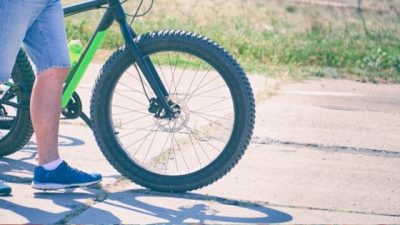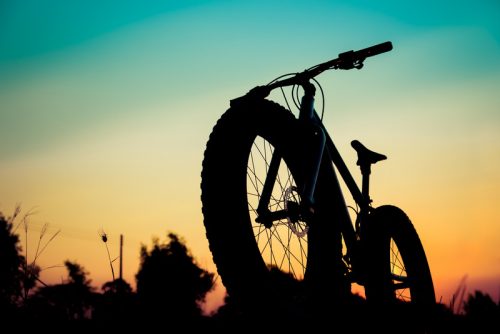Anyone remotely familiar with bicycles understands that the common theory is the thinner the tire, the faster the bike. That is why some people look at fat bikes and instantly think that there is no way any type of speed is achievable with them.
Indeed, a fat bike won’t be making an appearance in the Tour de France or any other type of cycling race like that in the near future. With that said, are fat bikes faster or slower, at least depending on public perception?
How Fat Tires Can Still Provide Speed
A wider tire must run at a lower pressure, which in turn gives more flex to the tire. In theory, it is looked at as a huge negative for anyone trying to go as fast as possible. However, it reduces the suspension losses, which evens things out a little more than people might think.
A fat tire indeed has to deal with a lot more friction with the ground. Not only that, but the frame of a fat bike is bigger and heavier compared to a road bike, or even a mountain bike for that matter.
Engineers have taken their time to craft fat bikes that make up for their build’s disadvantages as much as possible. That makes the current generation faster than any fat bike ever before. Besides reducing the weight and making things more aerodynamic, here are a few other reasons why fat bikes are still pretty fast.
Comfort
Comfortable bikes are usually viewed as not the fastest, but people need to stop looking at that as truly the case. There are a lot of benefits to using a comfortable bike, and that includes speed. A bike that feels comfortable and is easy to operate will use up less energy overall, and that can help with speeding around anywhere.
Fat bikes use very low tire pressure. There is no set amount of pressure, but rather a range for people to mess around with if they want. On the snow, a person can get away with less than 8 Psi in many cases. It will go up a few on trails and harder conditions, but certainly nothing like a road bike.
Finding that perfect psi is going to smooth out the ride and make it extremely comfortable. This means no wasted energy, and that in turn makes it a very fast ride overall. The less energy wasted by the rider, the easier it is to go faster and ride for a longer time. If the bike is not properly set up, riders often feel like they are fighting against the bike instead of working with it.
Stability
The reason why a lot of people consider fat bikes in the first place is that they offer the stability that can’t be found with any other type of bike on certain surfaces. Nobody wants to be riding a road bike, no matter how fast it is, off-road. A rider can only go as fast as they feel comfortable doing on a course, and stability matters a lot.
Fat bike tires have the width, the tread and more to provide ultimate stability when doing turns, going downhill and transitioning from different surfaces. A confident rider will be able to avoid having to slow down or even completely stop in some cases.
While a fat bike tire might lack the top speed of other types of bikes, its ability to adapt can shave time off during a longer ride because a person can keep their speed consistent throughout.
Stability also comes into play when racing a fat bike. Everyone has seen road bike races, and they’ve also seen just how crazy crashes can be. With so many riders packed in together, one person crashing can cause dozens of others to go flying.
There are certainly crashes with fat bikes, but stability allows people to avoid the situation a lot better. Riders usually just feel more confident riding very closely to others. This allows the group to go at a faster pace, even when including beginners.
Redistributed Weight
A high-end fat bike has dropped quite a bit of weight over the last decade. In fact, some manufacturers are getting fat bikes pretty much the same weight as mountain bikes. That’s pretty remarkable, considering all the added weight in the wheel area.
With the remaining weight, it is distributed in a way that makes it easier to manuever as well. It no longer feels like a rider is fighting against a fat bike, instead of working together with it. Some of the cheaper early models were truly disastrous to maneuver, and that left a bad taste in the mouths of many early adopters.
The best of the best fat bikes have perfected the build as of right now. There will always be improvements down the road, but the performance components of a fat bike, and its weight, is second to none.
Fat Bikes on Smoother Terrains

Fat bikes are often compared to mountain bikes when it comes to speed, and most mountain bikes do have a slight edge when conditions are ideal. The average speed difference is going to be hard to nail down depending on a variety of factors such as the bike, experience, components, and more. Some will say it’s as little as 1 MPH difference when everything is factored in.
The flatter and more consistent of a surface, the less a fat bike is actually necessary. That doesn’t mean it will stop working, but people can’t have realistic expectations to fly around on cement compared to other options.
Another thing working against fat bikes in a pure race is that they almost always lack gears. If there is any incline, it becomes increasingly difficult to tackle those hills or mountains. It doesn’t make as much of a difference when climbing off-road, because people aren’t trying to go that fast anyway. The grip is more important in that scenario, but continued peddling makes a big difference on the road.
Final verdict: Are Fat Bikes Fast?
Consumer demands for bikes are at an all-time high these days. In the early days, a fat bike didn’t necessarily have to be all that fast. People were only looking for certain qualities from the bike, and speed wasn’t at the top of the List.
Fat bikes are clearly more versatile now than ever before. They aren’t nearly as bulky, they have better components and they are just easier to control overall. This all leads to a faster experience, especially for someone who is a seasoned veteran riding bikes.
For its intended use, fat bikes are fast. They would not win in a road race, but no person would ever recommend a bike like that in the first place. That’s why for its purpose, the speed is there.
If a fat bike seems like it will fit into a lifestyle, don’t be afraid to give one a try. Too many people judge what the bike looks like on its cover, but it actually provides a good amount of value. Between opening up more trail and riding opportunities to providing a comfortable ride, speed will eventually come for anyone who is conditioned enough to handle a fat bike.


One thought on “Are Fat Bikes Faster or Slower Than a Mountain Bike?”